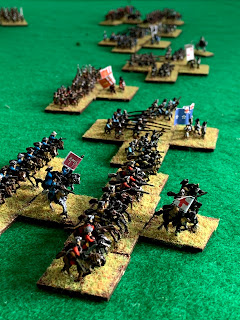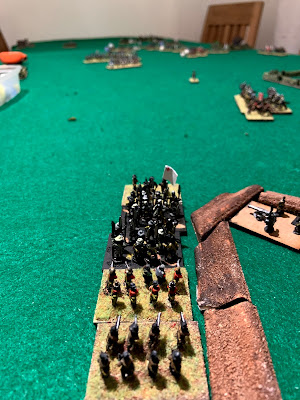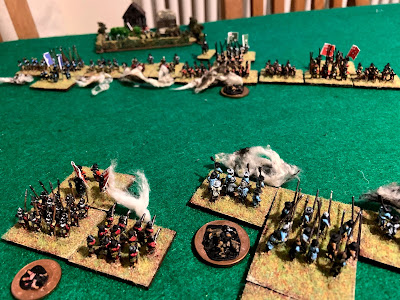I knew nothing of this except what I'd read some time ago in Charlie Wesencraft's 'With Pike and Musket', so I set to reading up what was on the internet rather than ordering books and waiting until they came. I subsequently ordered Barratt's booklet from Caliver along with another booklet on the Siege of Lyme.
I collated the numbers in the table at the bottom from various on line sources, then re-read both accounts of the wargame of the battle of Nantwich on Prometheus in Aspic. I went with 6 Roundhead battalia and five Royalist battalia of foot, assuming each was around 500 strong - this seems to fit the consensus on the numbers of men. For cavalry I decided on 6 and 4 respectively, in favour of the Roundheads. In addition each side had 2 bases of sakers, the Royalists had a musketeer unit, the Parlies a regiment of dragoons and 800 raw garrison troops in the Nantwich suburb of Welsh Row. To balance things a little I used M.Foy's troop ratings which made all but one of the Royalist foot, and one of the Royalist horse units veteran.
I measured out the distances between various landmarks on a modern map of the area of the battlefield, and added a rectangle to the dimensions of my table. After shifting the rectangle a few times I landed on what I thought was the optimal position. The tricky part of this is my table is not very deep so I have to be selective about what to include on the table top.
 |
| Black Tom cheers his lads on whilst Sir William Brereton prematurely enumerates poultry, confident that they will soon link up with the Nantwich garrison. |
 |
| The Royalist host, foot in checkerboard formation, advance to attack the Parliamentarians, hoping to catch them still in march column. |
 |
| Royalist view of the marching Roundhead column. |
 |
| View from Henhull farm of the approaching Royalist tertio. One of the rebels' battalia hasn't got the memo and marches across the front of the deployed sakers. |
 |
| The bloody firefight in the centre. |
 |
| Roundhead horse chase off the gunners and spike a pair of guns. |
 |
| From behind the Roundhead foot you can see the massive gaps appearing in the Royalist line. |
 |
| After 6 turns the Nantwich garrison can dice to join the fray. It takes a couple more turns before they do, arriving too late to make a difference. |
 |
| Royalist losses: 13 horse and 10 foot bases. |
 |
| Parliamentarian losses, not much lower at a total of 22 bases. |
Parliamentarians
|
Royalists
|
|||||||||
Link
|
Sources
|
Foot
|
Horse
|
Dragoons
|
Guns
|
Foot
|
Horse
|
Dragoons
|
Guns
|
|
Wikipedia
|
Young & Holmes, Rogers, BCW Project
|
4500 (Might incl garrison)
|
1800
|
500
|
2000
|
1800
|
||||
Battlefields of Britain
|
*
|
3000 (+2000 in garrison)
|
1500
|
500
|
2500
|
1000
|
||||
Battlefields Trust
|
None cited
|
2500-3000
|
1800
|
500
|
2500
|
1000
|
||||
BCW Project
|
**
|
3000 (+2000 in garrison)
|
1800
|
3500
|
||||||
Barrett, C.R.B (1896). Battles and Battlefields in England. London.
Bennett, M (1990). A Travellers Guide to Battlefields of the English Civil War. Webb and Bower Ltd, Exeter.
Beresford, M.W and St Joseph, J.K.S (1979). Medieval England - An Aerial Study. Cambridge University Press, Cambridge.
Burne, A.H (2005). Battlefields of England. Pen and Sword Books Ltd, Barnsley.
Cyprien, M and Fairbairn, N (1983). A Traveller's Guide to the Battlefields of Britain. Evans Brothers Ltd, London.
Dodds, G.L (1996). Battles in Britain 1066-1746. Arms & Armour, London.
Douglas, D.C, Coward, B and Gaunt, P (ed) (1975). English Historical Documents Vol 5B (1603-1660). Routledge, London.
Gardiner, S.R (1889). History of the Great Civil War Vol. II. London.
Green, H (1973). Guide to the Battlefields of Britain and Ireland. Constable, London.
Guest, K (1996). British battles: the front lines of history in colour. Harper Collins, London.
Hunt, T (2003). The English Civil War at First Hand. Orion Books, London.
Kinross, J (1979). The Battlefields of Britain. London.
Lancaster, J.H.D (2015). Nantwich: Battlefield visit notes and observations. CastlesFortsBattles.co.uk.
Ordnance Survey (2015). Nantwich. 1:1250. Southampton.
Roberts, K (2005). Cromwell's War Machine: The New Model Army 1645-60. Pen and Sword, Barnsley
Royle, T (2004). Civil War: The Wars of Three Kingdoms 1638-1660. Abacus, London
Smurthwaite, D (1993). The Complete Guide to the Battlefields of Britain. Michael Joseph, London.
Woolrych, A (2002). Britain in Revolution. Oxford University Press, Oxford.
|
||||||||||
** A.H. Burne & P. Young, The Great Civil War, a military history (London 1959)
S.R. Gardiner, History of the Great Civil War vol. i (London 1888)
Peter Gaunt, The Cromwellian Gazetteer (Stroud 1987)
Ronald Hutton, The Royalist War Effort 1642-46, (London 1999)
P.R. Newman Atlas of the English Civil War, (London 1985)
Stuart Reid, All the King's Armies (Staplehurst 1998)
Alf Thompson, Nantwich 1644 (Orders of the day, Volume 31, Issue 1, Jan/Feb 1999)
|
||||||||||











Excellent clash, Sir! Nantwich is not a battle to which I have more than cursory familiarity. In addition to your references, I vaguely recall having a Nantwich booklet by Partizan Press. I may be mis-remembering. Off to my library I go!
ReplyDeleteI enjoyed Tony's version to which you referenced and enjoyed your fight too! I ought to look into bringing this to my table too. "Ought" in the sense that it might be awhile...
Thanks Jonathan. It’s a nice manageable size. I think it’s the same booklet that I’ve ordered.
DeleteCracking! What a treasure trove of sources as well.. Would love to see your rules at some time?
ReplyDeleteCheers Steve. I need to write up my amendments, but happy to share the rules once I’ve done that. They’re only five pages long and are nothing special.
DeleteTerrific - looks and reads like a lot of fun. I must say I have a soft spot for these regional campaigns - smaller battles, on interesting battlefields. As a side-issue, I was trying to find out more about Fulk Huncke (who apparently wasn't present, his regiment being commanded on the day by a Major Hammond) and kept getting swamped with Googlisms connected with wrestling. To clarify things, I added +ECW to the search, and things got even worse, since (apparently) ECW is also a wrestling organisation. Oh well.
ReplyDeleteAnd that’s how you explained to the Contesse why you were looking at pictures of butch men in leotards!
DeleteAnyway, that’ll learn me for using secondary (tertiary ?) sources.
It was very enjoyable. Not as involved as my recent SYW epics, but then it didn’t take as long.
Super battle and nice and even up until the end, surely the sign of a good battle! Plus the right side won!
ReplyDeleteBest Iain
I was worried at one point when the Roundheads went 4:0 up. Though to be fair it did look distinctly dicey for Fairfax early on.
DeleteNo apologies needed old fruit, looks like lots of fun was had - which is the point after all.
ReplyDeleteAnother excellent battle in your ECW 'series'. Looks wonderful and all that pre-game research and planning seems to have paid off.
ReplyDeleteCheers James. It was fun and the ‘research’ was light reading. Would have been better if I’d had the Barratt book before, but it’s on the way now.
Delete